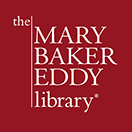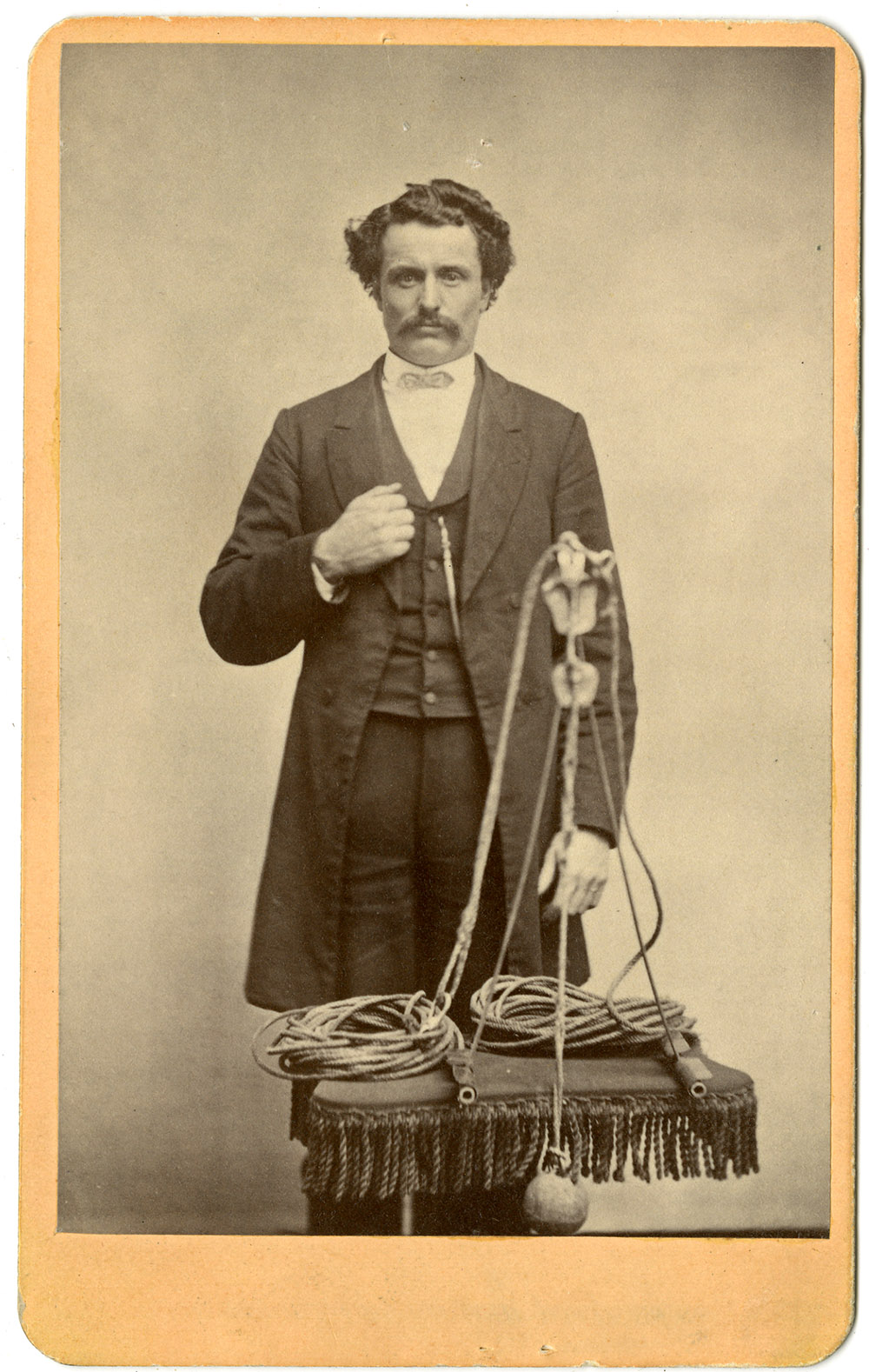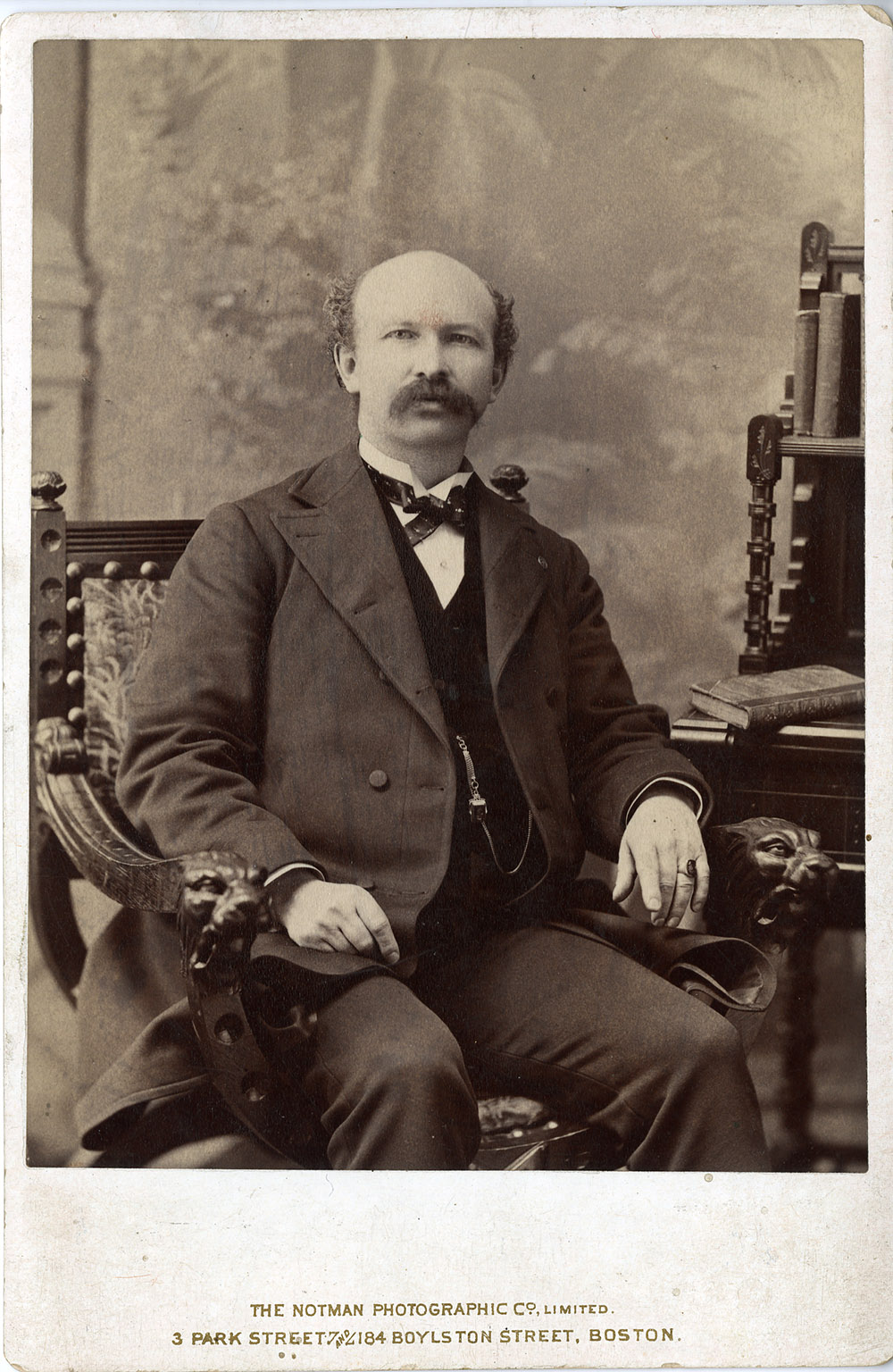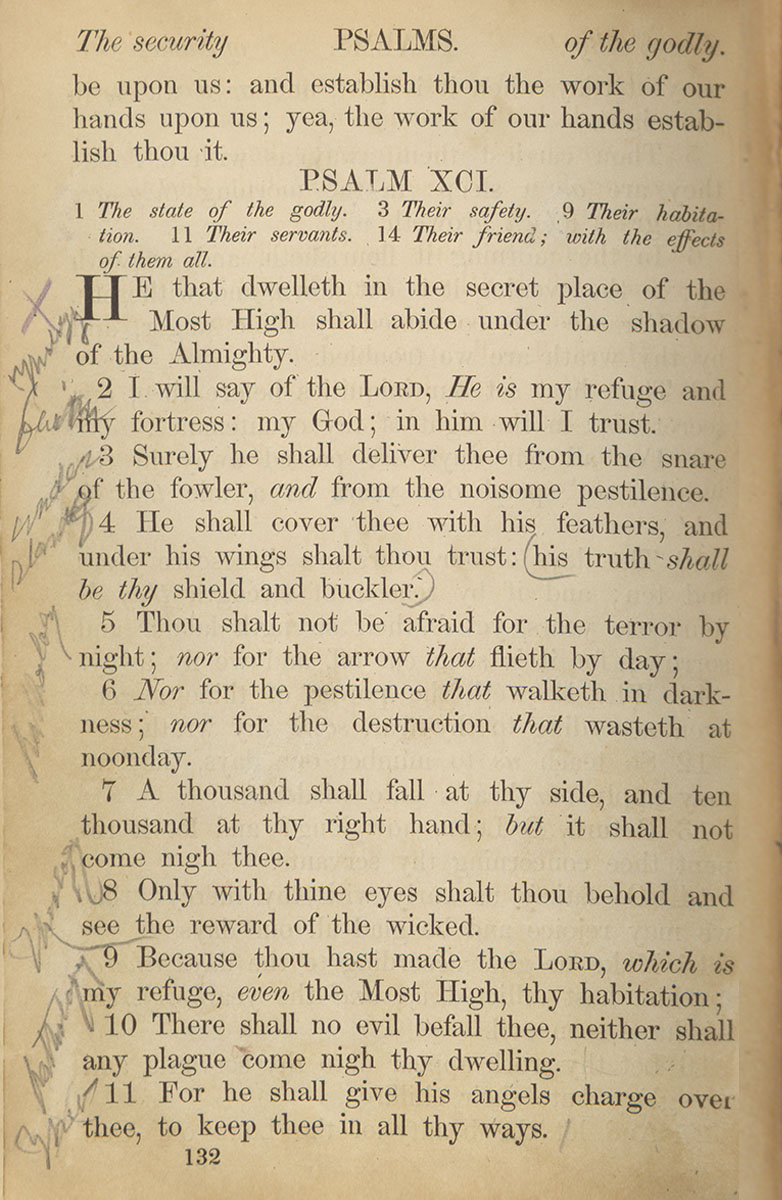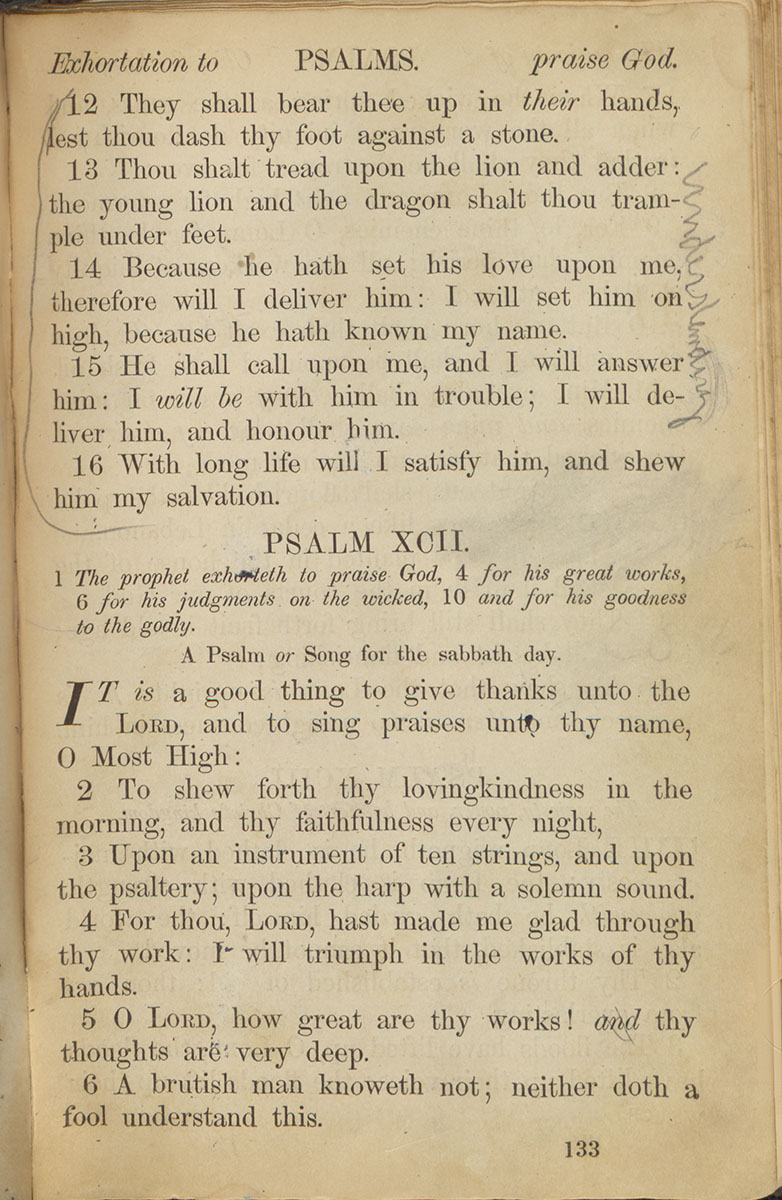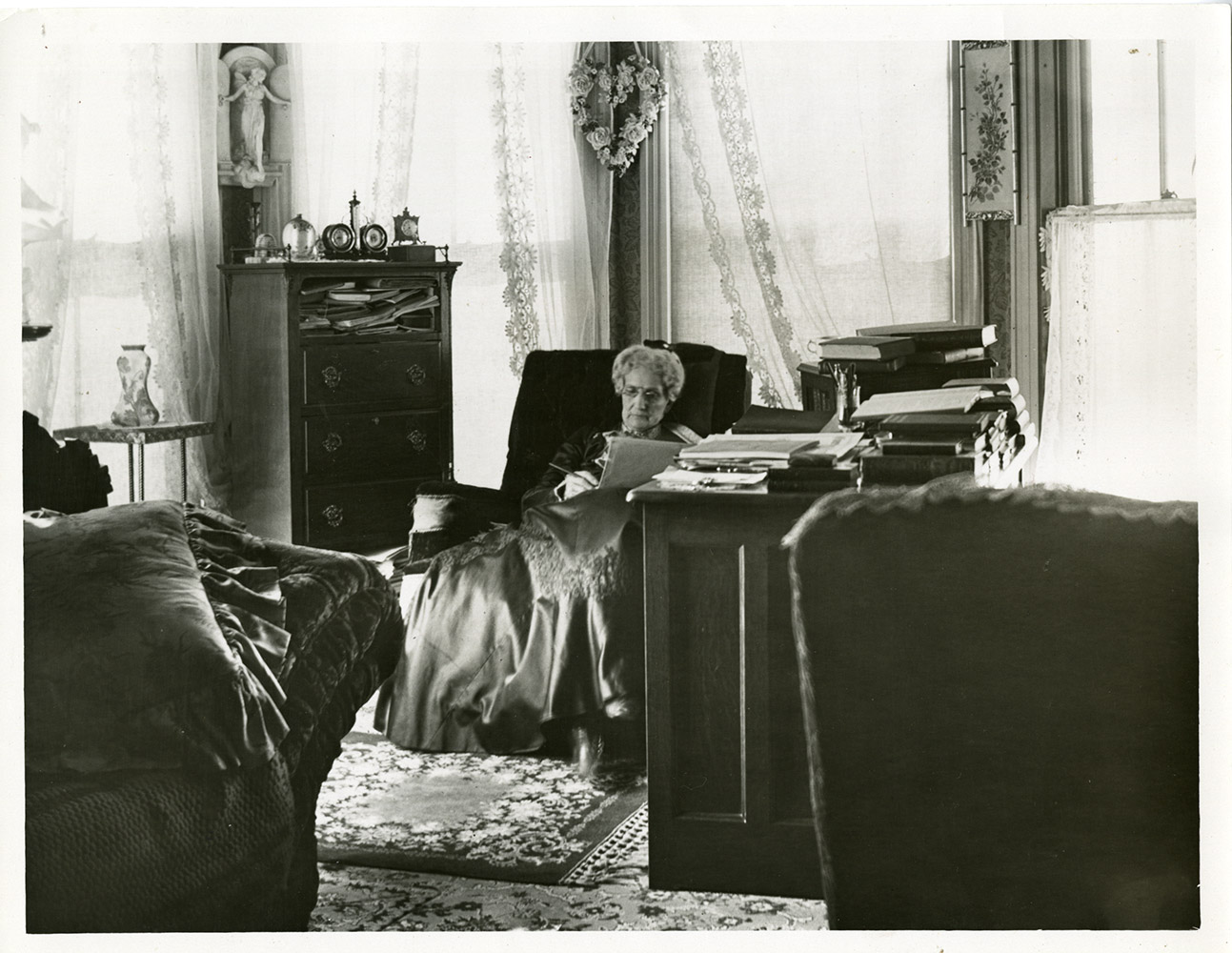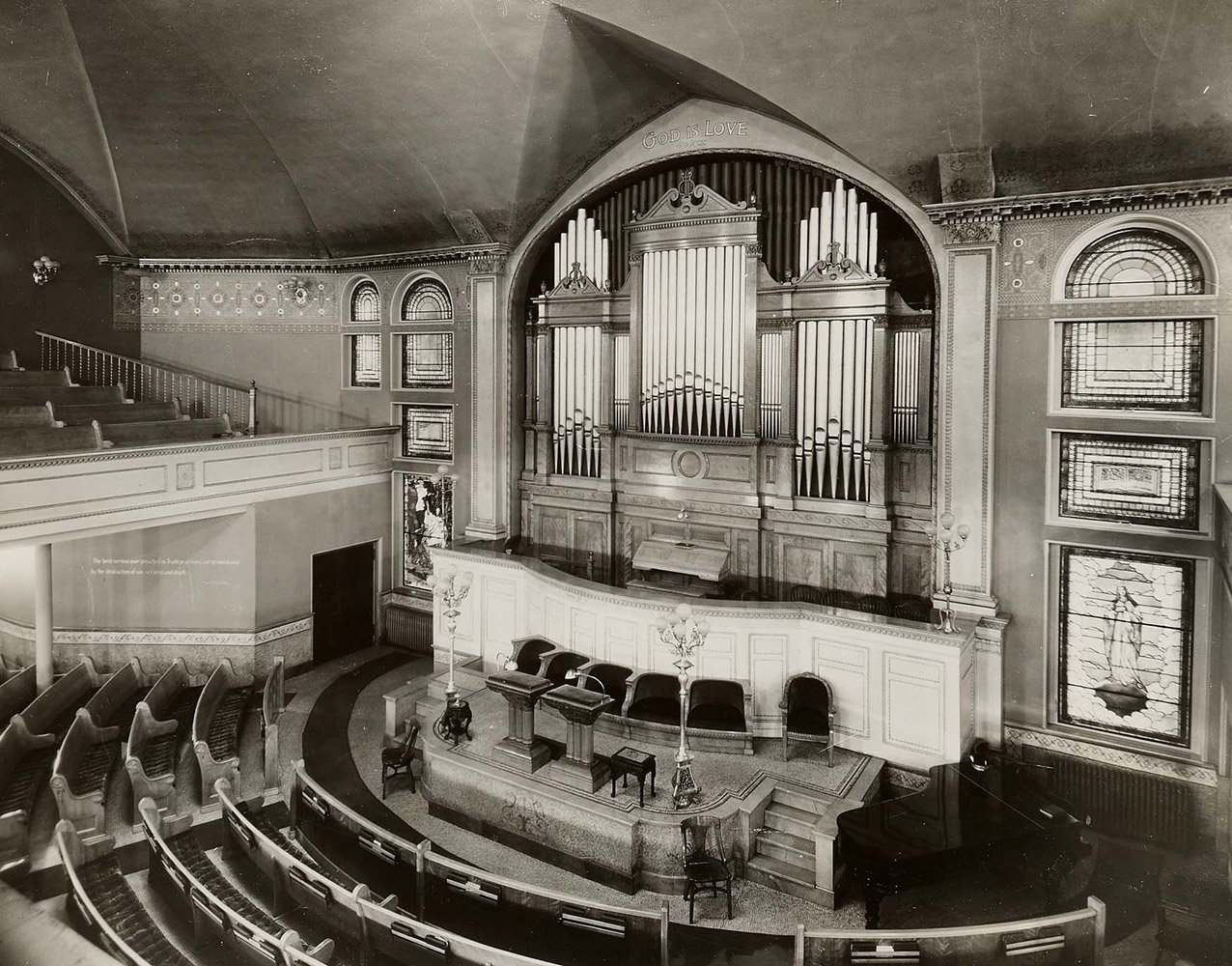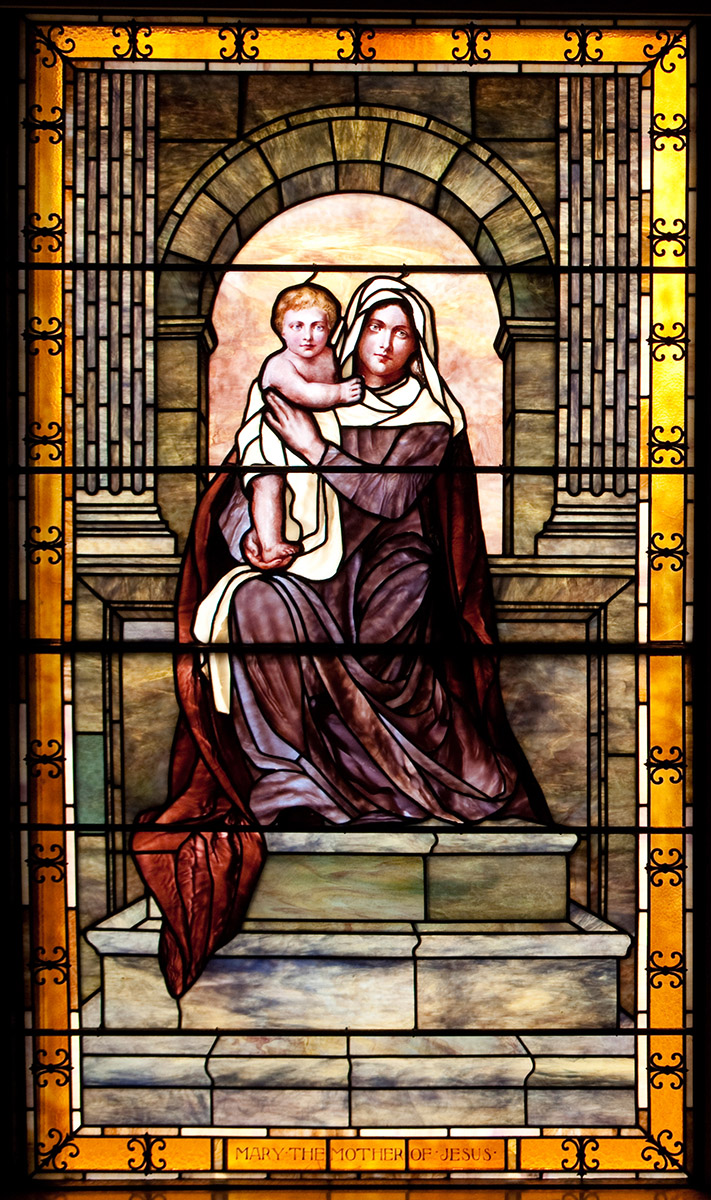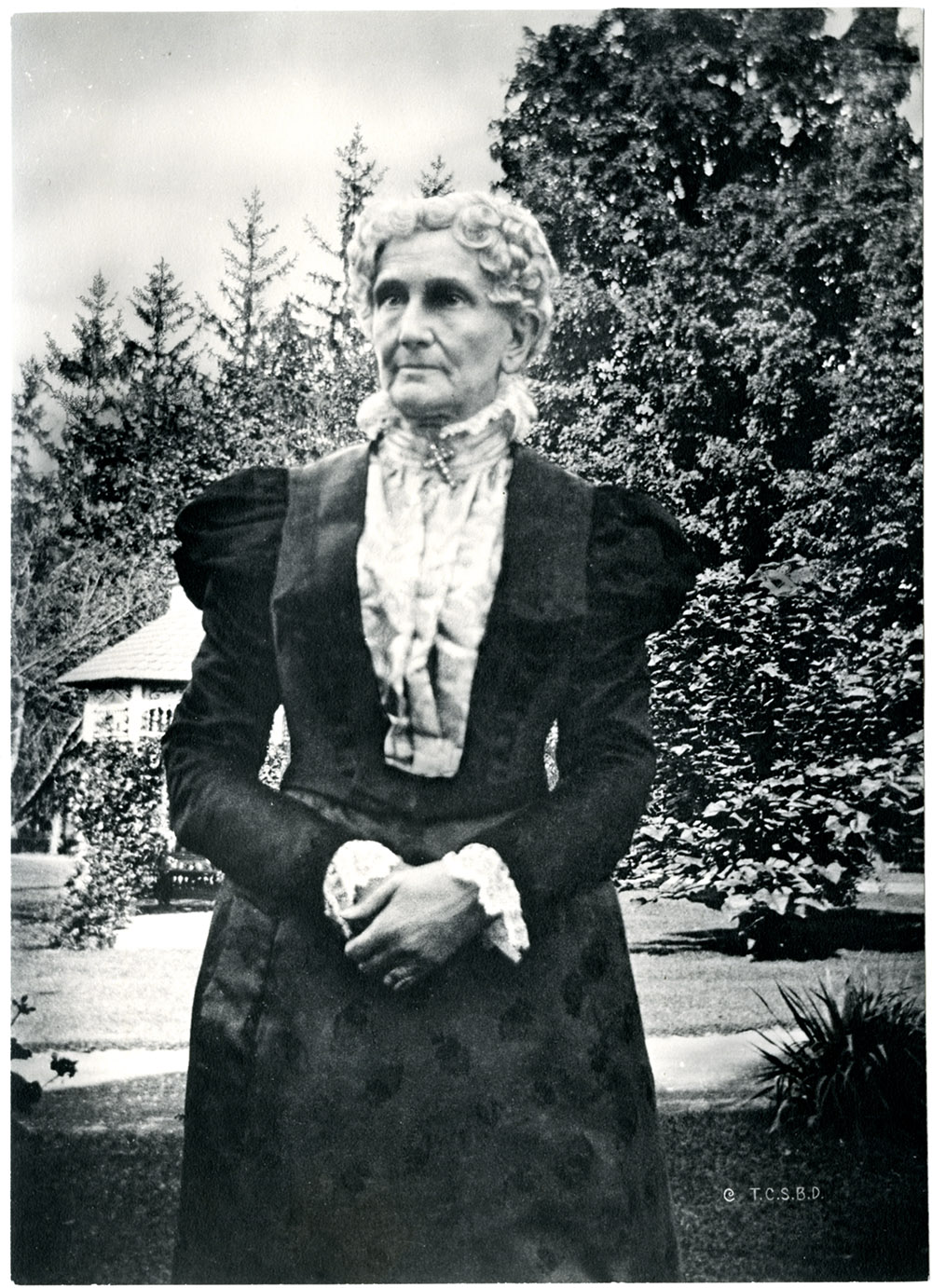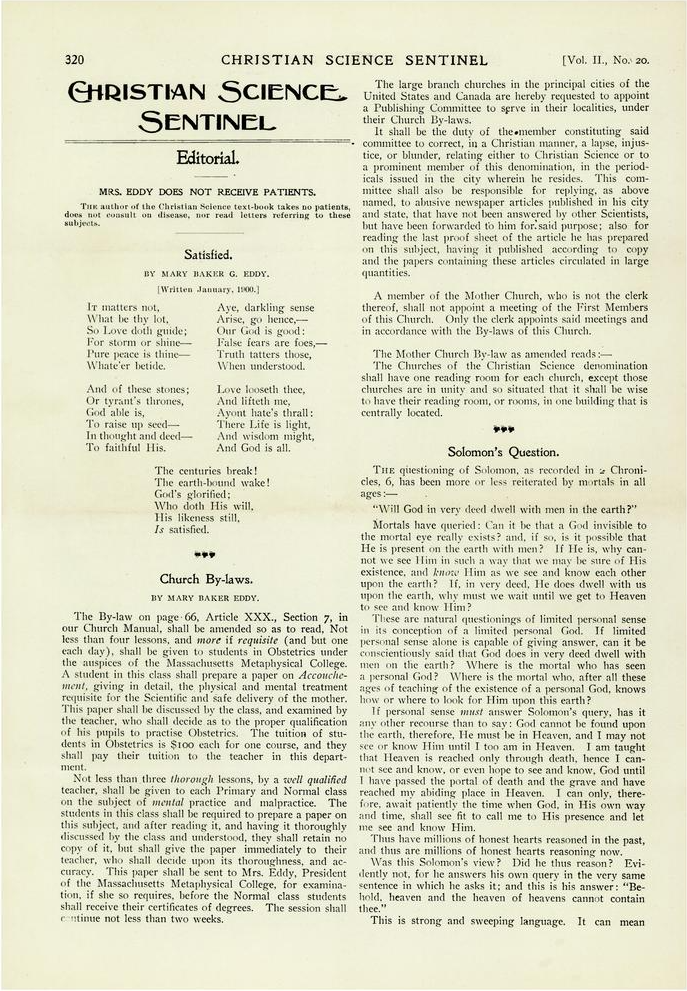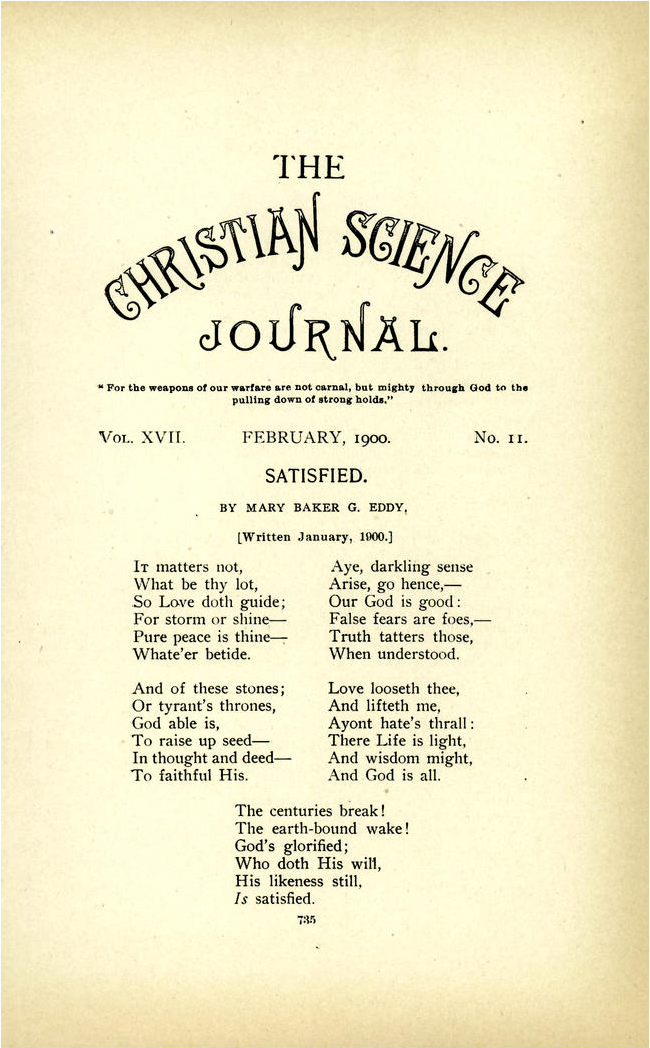The Christian Science Hymnal: History, Heritage, Healing
The Christian Science Hymnal: History, Heritage, Healing
The Christian Science Hymnal: History, Heritage, Healing
Listen to this article
Chapter 13
Mary Baker Eddy’s hymns, part 2
Chapter 12 of this series discussed Mary Baker Eddy’s accomplishments as a poet and explained how seven of her prominent poems were set to music as hymns. The chapter went on to show this regarding three of her works: “Christ My Refuge” (1868), “Communion Hymn” (1876), and “‘Feed My Sheep’” (1887). Here the discussion continues, providing a history of the remaining four hymns by Eddy that appear in the Christian Science Hymnal.
“Mother’s Evening Prayer” (1893)
In February 1914 The Christian Science Journal referred to this work as “perhaps the most complete poetic expression alike of Mrs. Eddy’s religious teachings and of her own human experience and hope.” Here we find a mother possibly offering a prayer for her long-absent son George, or her adopted son Ebenezer J. Foster Eddy—but most certainly for her church. The Journal went on to observe that “asking for protection for her fledgling idea, and in affirming her assurance of protection, she says: ‘His arm encircles me, and mine, and all.’”1
In 1889 Eddy took several bold steps, moving to reshape her church. She departed Boston in May and eventually settled in Concord, New Hampshire. Over the next few months she dissolved both the Christian Scientist Association and the Massachusetts Metaphysical College. Then on December 2 the Church of Christ (Scientist) abandoned its congregational organization and continued to hold services as a voluntary association. Over the next three years, Eddy undertook an extensive revision of Science and Health with Key to the Scriptures. She formally reorganized The Mother Church in September 1892.2 Soon after, the first edition of the Hymnal was published (see Chapters 2 and 3).
Not long after this, Eddy was also writing “The Mother’s Evening Prayer.” Its first verse appeared in the June 1893 Journal, as part of her article “Things and Thoughts,” with this introduction:
When the white-winged dove fed her callow brood, nestled them under her wings, and with tremulous tenderness called them to her breast, did you thank God for that redemptive strain from lips which taught you the Lord’s Prayer? and for that mother’s silent orison breathing thus:—3
Eddy finalized “The Mother’s Evening Prayer” over the next two months, and it was published in its entirety in the August 1893 Journal. Interestingly, this is the only one of those seven poems written in a familiar meter, iambic pentameter—a line of verse with five metrical feet, each consisting of one short (or unstressed) syllable, followed by one long (or stressed) syllable:
Oh gentle presence, peace and joy and power;
Oh Life divine, that owns each waiting hour,
Thou Love that guards the nestling’s faltering flight!
Keep Thou my child on upward wing to-night.
Love is our refuge, only with mine eye
Can I behold the snare, the pit, the fall;
His habitation high is here, and nigh,
His arm encircles me, and mine, and all.
Oh make me glad for every scalding tear,
For hope deferred, ingratitude, disdain!
Wait, and love more for every hate, and fear
No ill–since God is good, and loss is gain.
Beneath the shadow of His mighty wing;
In that sweet secret of the narrow way,
Seeking and finding, with the angels, sing:
“Lo! I am with you alway,”–watch and pray.
No snare, no fowler, pestilence or pain;
No night drops down upon the troubled breast,
When heaven’s aftersmile, earth’s teardrops gain,
And mother finds her home and far-off rest.4
Click image to enlarge
George W. Glover II, c. 1870–1871. Whitney and Zimmerman Photographers, St. Paul, Minnesota. P00803.
Click image to enlarge
Ebenezer J. Foster Eddy, undated. Notman Photographic Co. Limited, Boston. P00603.
In 1898, years before this poem became a hymn, William Lyman Johnson composed a solo version and sent it to Eddy. The final version appeared as Hymn 197 in the 1910 edition of the Hymnal.
The substance of this poem reflects Eddy’s deep reliance on the ninety-first Psalm. In a 1898 address, she cited what she called “this Psalm of the royal Hebrew bard,” which has “no peer in psalmody” but “is the pearl of the psalter.”5 The second verse of the poem references the psalm’s second and third verses:
Love is our refuge; only with mine eye
Can I behold the snare, the pit, the fall:
His habitation high is here, and nigh,
His arm encircles me, and mine, and all.
The final stanza also alludes to the third verse. Eddy’s resolve to provide her church—her child—with an increasingly solid foundation was tested again and again. The “ingratitude” of her son George, the “disdain” of friends as well as strangers, the departure and treachery of once-loyal workers, the “scalding tears” and “deferred hopes,” all challenged her to “wait, and love more for every hate” and to keep her vision on the larger prize—the gift to the world of a religion that explained and promoted Jesus’ example of spiritual healing.
Click images to enlarge
Eddy’s copy of The Book of Psalms: translated out of the original Hebrew, and with the former translations diligently compared and revised (New York: American Bible Society, 1879). B00016.
“At this point there is a definite division of the poem,” Johnson observed in a letter. “The first, second and third stanzas have dealt with things spiritual and mortal…but the next two stanzas contain nothing but the spiritual.” These are the verses he was referring to:
Beneath the shadow of His mighty wing;
In that sweet secret of the narrow way,
Seeking and finding, with the angels sing:
“Lo, I am with you alway,”—watch and pray.
No snare, no fowler, pestilence or pain;
No night drops down upon the troubled breast,
When heaven’s aftersmile earth’s tear-drops gain,
And mother finds her home and heav’nly rest.
Click image to enlarge
Mary Baker Eddy in her study, c. 1892–1908. Calvin A. Frye. P00036. © The First Church of Christ, Scientist.
Eddy’s original reference to “far-off rest” in the last verse was still present when the poem was reprinted in the Christian Science Sentinel on December 11, 1909. Along these lines, her student Adam H. Dickey, one of her secretaries, recalled an occasion when he found her looking through the poem:
She made a change in the words “mother finds her home and far-off rest” by erasing far-off and inserting the word heavenly, as it now reads. She asked me what I thought of the change. I told her that to me it conveyed a much better thought. I said that “her home and far-off rest” carried the impression that she had a long and toilsome way ahead of her. She said, “That is just the thing I want to get rid of.”6
Hymn settings of "Mother's Evening Prayer"
● Hymn 197 (MORECAMBE): Eddy approved the proofsheets of “The Mother’s Evening Prayer” set to this 1870 melody by Frederick C. Atkinson, well-known in other Protestant churches.7 At her request, Albert F. Conant, Organist of The Mother Church, changed the last notes in the first verse and created “the ascending phrase for the words ‘on upward wing tonight’”—a clever bit of word-painting that suited the words beautifully.8
1932 Hymnal:
● Hymn 207 (MORECAMBE,) Frederick C. Atkinson (arr. Albert F. Conant)
● Hymn 208 (BENEDICTION/ELLERS), Edward J. Hopkins
● Hymn 209 (EXPECTATION), Andreas P. Berggreen
● Hymn 210 (LIMPSFIELD), Andrew Freeman
● Hymn 211 (PRESENCE), Percy Whitlock9
Hymn 212 (SONG 22), Orlando Gibbons10
2017 Hymnal:
● Hymn 539 (SANDRA’S MELODY), Lisa Redfern
● Hymn 540 (HALMONI), Susan Booth Mack Snipes
“Mother’s Evening Prayer” (Hymn 208), sung by Rose Bampton, Mary Baker Eddy Hymns, Vol. II (1949)
“O Gentle Presence” (Hymn 540), sung by Kendra Fogg, A Quiet Prayer: Hymns of Comfort (2025)
“Love” (1896)
Between 1893 and 1896, Eddy continued to shepherd her church, holding steadfastly to a guiding principle that God is Love. In June 1896 she published a poem titled “Love” in the Journal, which included the statement “Love alone is Life.” Between the publication of “The Mother’s Evening Prayer” and “Love,” three significant events had occurred. On December 30, 1894, the first service was held in the Original Edifice of The Mother Church, just days after the Bible and Science and Health had been ordained as pastor of the church. Then in September 1895 the first edition of the Manual of The Mother Church was published.
It was perhaps inevitable that Eddy was inspired to write a poem on the topic of love, given the central place this quality held in her thought. In her books she capitalized the word Love (as a synonym for God) on 943 occasions, and employed it as love 642 times, including these examples:
Click image to enlarge
Original Edifice of The Mother Church in Boston, undated. P08007. © The First Church of Christ, Scientist.
What a word! I am in awe before it. Over what worlds on worlds it hath range and is sovereign! the underived, the incomparable, the infinite All of good, the alone God, is Love….11
The vital part, the heart and soul of Christian Science, is Love….12
… Remember that the first and last lesson of Christian Science is love, perfect love, and love made perfect through the cross….13
As the movement grew, Eddy worked constantly for harmony to prevail among Christian Scientists, consistently writing letters to her students, urging them to show more of the spirit of love and unity that she saw as the very heart of Christian Science. Around January 1890 she wrote this in a letter to her student Laura Lathrop:
… Love, love alone, will found, upbuild, and establish forever both the Christian Scientist and our Cause. But envy, jealousy, or rivalry, will kill the spirit of this Science in the person who possesses it and will thwart the establishment of it in this age….14
Click image to enlarge
Sue Harper Mims, undated. P01344.
During Eddy’s final class in 1898, Sue Harper Mims remembers her teacher asking the class to consider this question:
…“What is the best way to do instantaneous healing?” Many arose. Some said, “Realize the ever-presence of good”; others, “Deny the claims of evil.” There were many answers, but when they had finished, she said, as I remember: “I will tell you the way to do it. It is to love! Just live love–be it–love, love, love. Do not know anything but Love. Be all love. There is nothing else. That will do the work. It will heal everything; it will raise the dead. Be nothing but love.”15
We see this thought expressed in the last two lines of verse one and in verse two, which specifically points to Jesus’ example of love to all humanity:
Brood o’er us with Thy shelt’ring wing,
’Neath which our spirits blend
Like brother birds that soar and sing,
And on the same branch bend.
The arrow that doth wound the dove
Darts not from those who watch and love.
If thou the bending reed wouldst break
By thought or word unkind,
Pray that his spirit you partake,
Who loved and healed mankind:
Seek holy thoughts and heavenly strain,
That make men one in love remain.
“Wisdom’s rod” in verse three could be seen as a poetic version of this statement in Science and Health: “Through the wholesome chastisements of Love, we are helped onward in the march towards righteousness, peace, and purity, which are the landmarks of Science.”16 Elsewhere she wrote in The First Church of Christ, Scientist, and Miscellany, “Love atones for sin through love that destroys sin. His rod is love.”17
Learn, too, that wisdom’s rod is given
For faith to kiss, and know;
That greetings glorious from high heaven,
Whence joys supernal flow,
Come from that Love, divinely near,
Which chastens pride and earth-born fear,
Verse four gives a sense of Eddy’s concept of the universe as spiritual, as she expressed it in Science and Health: “Eternal Truth is changing the universe…. ‘Let there be light,’ is the perpetual demand of Truth and Love, changing chaos into order and discord into the music of the spheres.”18
Through God, who gave that word of might
Which swelled creation’s lay:
“Let there be light, and there was light.”
What chased the clouds away?
’Twas Love whose finger traced aloud
A bow of promise on the cloud.
What exactly was the “bow of promise”? A statement from Eddy’s book The People’s Idea of God suggests a possibility: “Let us rejoice that the bow of omnipotence already spans the moral heavens with light, and that the more spiritual idea of good and Truth meets the old material thought like a promise upon the cloud, while it inscribes on the thoughts of men at this period a more metaphysical religion founded upon Christian Science.”19
In the final verse of this poem, Eddy returns to the central “Love alone” theme, as stated in the Manual, which she had published just the year before: “In Science, divine Love alone governs man; and a Christian Scientist reflects the sweet amenities of Love, in rebuking sin, in true brotherliness, charitableness, and forgiveness.”20
Thou to whose power our hope we give,
Free us from human strife.
Fed by Thy love divine we live,
For Love alone is Life;
And life most sweet, as heart to heart
Speaks kindly when we meet and part.
Eddy’s increasingly clear expression of the metaphysical concepts in her poems is seen in the fact that she changed only one word in this poem over the course of time; in the second verse, the words “you partake” replaced “all partake.” She also made two capitalization changes. First, “His spirit” became “his spirit” in verse two, to indicate that she was referring to Jesus. And in verse three, “high Heaven” became “high heaven.” The only other changes made concerned punctuation.
Hymn settings of "Love"
Surprisingly, although “Love” was published in 1896, the poem did not make its entrance into the Hymnal until 1932. By contrast, “Christmas Morn,” which she published two years later, was added to the 1903 printing at her request.21
1932 Hymnal
● Hymn 30 (LOVE), Walter E. Young. This setting was composed specifically for Eddy’s words.
● Hymn 31 (VITA), Eaton Joseph Fanning. This unison setting of VITA (“life”) was adapted to fit Eddy’s words.
● Hymn 32 (GOTTLOB), Walter E. Young. This tune removed one or two notes from Johann Sebastian Bach’s chorale “Gottlob” (“Praise God”) and adapted it to Eddy’s text.
2008 Supplement
● Hymn 434 (NOCTURNE), Peter B. Allen
● Hymn 435 (BROTHER JAMES’ AIR adapted), Robert Rockabrand
2017 Hymnal
● Hymn 452 (BROTHER JAMES’ AIR adapted), Robert Rockabrand
● Hymn 453 (LILY), Désirée Goyette
● Hymn 454 (BROTHER BIRDS), James R. Corbett
● Hymn 455 (LOVE), Melanie H. Alcázar
● Hymn 456 (NOCTURNE), Peter B. Allen
“Brood o’er us with Thy shelt’ring wing” (Hymn 30), sung by the Candlewood Singers, Let Gladness Ring (1999)
“Brood o’er us with Thy shelt’ring wing” (Hymn 455), Christian Science Hymnal: Hymns 430–603 (audio edition, 2017)
“Christmas Morn” (1898)
Eddy loved Christmas, and over her lifetime she wrote repeatedly about that special season. “The basis of Christmas is the rock, Christ Jesus …,” she told the New York World. “The basis of Christmas is love loving its enemies, returning good for evil, love that ‘suffereth long, and is kind.’”22 And in a 1907 Ladies’ Home Journal article titled “What Christmas Means to Me,” she began:
To me Christmas involves an open secret, understood by few — or by none — and unutterable except in Christian Science. Christ was not born of the flesh. Christ is the Truth and Life born of God — born of Spirit and not of matter. Jesus, the Galilean Prophet, was born of the Virgin Mary’s spiritual thoughts of Life and its manifestation….23
The year 1898 was another one of significant activity. Eddy founded the Christian Science Board of Lectureship and the Committee on Publication. She organized The Christian Science Publishing Society, developed 26 subjects for the Bible-Lessons, and published the first issue of The Christian Science Weekly.24 That March the first Christian Science church in Germany was organized in the city of Hannover. And that December the Journal published her poem “Christmas Morn,” under the title “Christmas Hymn.”25 This work synthesizes many of Eddy’s reflections on Christmas.
According to historian Stephen Gottschalk, “Christmas Hymn” clearly expressed the sense of a spiritual breakthrough associated with the year 1898:
Unlike most of [Eddy’s] other religious poetry, this poem, revised as “Christmas Morn,” did not reflect a deep need of the movement as Eddy felt it. Rather, it celebrated, as its first stanza illustrates, the newness and spiritual light that had been breaking through in various ways during the course of the year ….26
Unlike the previous two poems, Eddy made multiple, significant changes to “Christmas Morn” before it appeared in its final form, in the 1903 Hymnal.
Click image to enlarge
Stained glass window in The Mother Church Original Edifice: “Mary the Mother of Jesus.” Photo by Taylor Weidman, The Christian Science Monitor. © The Christian Science Publishing Society.
Original Version
“Blest Christmas Morn”
Blest Christmas morn, could murky clouds
Pursue thy way
Or light be born? no storm enshrouds
Thy dawn or day!
Dear Christ, forever here and near,
No cradle song,
Nor natal hour and mother’s tear,
To thee belong.
Thou God-idea, Life-encrowned,
The Bethlehem babe
Beloved, adored, replete, renowned,
Was but thy shade.
Thou living gleam of deathless Love,
little Life!
So infinite – so far above
All mortal strife,
Or creed, or earth-born taint,
Fill us to-day
With all thou art-be thou our saint-
Our stay, alway.
Final Version
“Blest Christmas Morn”
Blest Christmas morn, though murky clouds
Pursue thy way,
Thy light was born where storm enshrouds
Nor dawn nor day!
Dear Christ, forever here and near,
No cradle song,
No natal hour and mother’s tear,
To thee belong.
Thou God-idea, Life-encrowned,
The Bethlehem babe –
Beloved, replete, by flesh embound –
Was but thy shade!
Thou gentle beam of living Love,
And deathless Life!
Truth infinite, – so far above
All mortal strife,
Or cruel creed, or earth-born taint:
Fill us today
With all thou art – be thou our saint,
Our stay, alway.
Click image to enlarge
Mary Baker Eddy in her garden, c. 1900. Clara S. Shannon. P00217. © The First Church of Christ, Scientist.
In the first decade of the twentieth century, the 1898 Hymnal was printed yearly, with new hymns inserted as older ones were deleted. In early 1903 Eddy sent a request to the Board of Directors:
Beloved Students: I enclose a poem that I want to have published in our Hymnal before next Christmas. Also will you find music adapted to the words or rather in unison with their spirit and set to these verses. I want a kind of music that is plaintive and inspiring not noisy but melodious – from the old Masters such as Handel.27
The Sentinel alerted readers to the insertion of the hymn in late November.
Mrs. Eddy’s Christmas Hymn
We have further reason for gratitude to our Leader, Rev. Mary Baker G. Eddy, for she has given us a new song, entitled “Christmas Morn,” to be used in our church services, thus proving once more that she is ever watchful over the Cause she loves so well, and to which her time and labors are so freely given. This poem displays, in a marked degree, the originality of thought, beauty of expression, and keen spiritual insight which characterizes all Mrs. Eddy’s writings, and it is a fitting companion to her other hymns, which have become so dear to Christian Scientists.
Beginning with December 1, 1903, the Christian Science Hymnal will contain this poem, set to two appropriate tunes for congregational singing.28
Hymn settings of "Christmas Morn"
As a result of Eddy’s letter to the Directors, a musical setting to “Christmas Morn” titled “Serenity” was inserted, arranged by Mother Church organist Albert F. Conant, from William V. Wallace. Additionally an original setting appeared, with the tune name “Christmas Morn,” composed by Conant himself.
1903–1909 printings
● Hymn 186 (SERENITY), arr. from W. V. Wallace
● Hymn 189 (CHRISTMAS MORN), Albert F. Conant
Reminiscences by Laura C. Conant, Albert Conant’s wife, include a story concerning his setting of “Christmas Morn”:
I distinctly recall the time when Mrs. Eddy asked him to find a setting for her poem, “Christmas Morn.” A special delivery letter came from her one Saturday night, while we were living in Boston.… Saturday was the regular Symphony Concert night, and we had tickets for the concert on that particular evening…. She told him that she had been trying to find music for this poem, as she wished to place it in the Christian Science Hymnal. Settings had been sent her which she did not consider appropriate. She wanted music that would appeal to the “heart and not the head.” She also said, “My words require the depths of harmony, both plaintive and joyous.” Mr. Conant suggested that I go alone to the concert, and said that he would have something to play for me when I returned. When I came home two hours later, he played for me the hymn, essentially as it stands today in our hymnal, Hymn No. 24. The next day he sent it to Mrs. Eddy, and with it the music by Wallace [23 “Serenity”], which he selected. By return mail she asked to have them put into the Christian Science Hymnal.29
1910 Hymnal:
● Hymn 186 (SERENITY), arr. from W.V. Wallace
● Hymn 189 (CHRISTMAS MORN), Albert F. Conant
1932 Hymnal:
● Hymn 23 (SERENITY), arr. from W.V. Wallace
● Hymn 24 (CHRISTMAS MORN), Albert F. Conant
● Hymn 25 (KINGTON), F. Llewellyn Edwards
● Hymn 26 (DRANSFIELD), G. Thalben-Ball
● Hymn 27 (INFINITAS), Percy Whitlock
● Hymn 28 (SELWORTHY), E. Norman Greenwood
2008 Supplement:
● Hymn 432 (NEWBORN), Fenella Bennetts
● Hymn 433 (HODGSON), Robert Rockabrand
2017 Hymnal:
● Hymn 449 (CLARITY), Désirée Goyette
● Hymn 450 (NEWBORN), Fenella Bennetts
● Hymn 451 (HODGSON), Robert Rockabrand
“Christmas Morn” (Hymn 23), sung by Rebecca Minor, Embraced (2018)
“Christmas Morn,” sung by Michael Sutton, The Gift of Gratitude (1988)
“Satisfied” (1900)
The end of the nineteenth century saw the growth of Christian Science, as well as ongoing hostile reaction to its influence from some sectors of the press and clergy. Eddy faced this constant antagonism with grace and confidence. In January 1900 she greeted the new year with a poem titled “Satisfied” (including the phrase “the centuries break”).30 The opening lines—“It matters not / What be thy lot, / So Love doth guide”—convey an absolute certainty in the power of Love to lift one above what Science and Health calls “the dark recesses of mortal thought.”31 “Satisfied” was quickly published in the Sentinel on January 18, as well as in the February Journal.32 Of Eddy’s seven poems that became hymns, this one is unique. It is the singular example of a poem for which she saw no need to revise the text, aside from making minor punctuation edits.
Again, we see the ideas Eddy focused on in this poem already well-developed in her earlier writings.
As with the previous six poems that she composed between 1868 and 1900 that were eventually set to music as hymns, “Satisfied” is in essence a prayer. It also shows a traceable relation to the needs and struggles she faced in founding Christian Science. Perhaps in no instance is her sense of abandonment to God more pronounced than in this poem. But unlike the other poems, which address God directly, “Satisfied” builds on a sense of the immediate divine presence, while directly addressing the evil that seems so threatening: “Aye, darkling sense, arise, go hence!” The next stanza conveys in the line “Ayont [beyond] hate’s thrall” the specific nature of that “darkling sense,” as well as our ability to move beyond its range.
The real point of the poem, however, is not the magnification of human hatred. Rather it is the capacity of God as Love to offset and defeat worldly hatred—the recognition that “Love looseth thee, and lifteth me, ayont hate’s thrall.”33
Hymn settings of "Satisfied"
As previously stated, although “Satisfied” was published in 1900, it did not appear in the Hymnal until 1932.
1932 Hymnal
● Hymn 160 (GLOAMING), John Stainer
● Hymn 161 (FORTITUDE), Walter E. Young
● Hymn 162 (SATIS), Percy Whitlock
2008 Supplement
● Hymn 447 (MKHAYA), Andrew D. Brewis
2017 Hymnal
● Hymn 513 (MKHAYA), Andrew D. Brewis
● Hymn 514 (HUDSON), Mindy Jostyn
● Hymn 515 (GRATITUDE), Ryan Vigil
“Satisfied” (Hymn 161), congregational singing at The First Church of Christ, Scientist, Boston, April 16, 2017. William Burden, song leader.
“Satisfied,” sung by Mindy Jostyn, In His Eyes (1998).
Click image to enlarge
Mary Baker Eddy, “Satisfied,” Sentinel, 18 January 1900, 320.
Click image to enlarge
Mary Baker Eddy, “Satisfied,” Journal, February 1900, 735.
The legacy of seven hymns
According to the 1914 Journal article “Mrs. Eddy’s Hymns,” each of Eddy’s poems was “written in the midst of an enormous activity, during the years when she was declaring, teaching, and establishing Christian Science and its world-wide organization.” As such, “her poems and hymns were interludes, as it were, in these long labors…. They express herself, – aspiration, abnegation, struggle, victory, unselfish love; the sorrowing and triumphing Leader, the friend of humanity, the mother of her flock.”34
1868…1876…1887…1893…1896…1898…1900. The seven poems Eddy wrote in these years helped chronicle her life, as she moved—at times with her own “bleeding footsteps”35—to a basis more firmly grounded in Spirit. In her own words, Eddy embodied “the sturdy pioneer” who “hew[ed] the tall oak” and “cut the rough granite,” knowing that “future ages” would record and understand what she accomplished in establishing a religion based on healing.36
Through the years of solitude, enduring family and professional hostility and dealing with students whose faith was shallow, Eddy continued to yield to God’s direction in guiding her movement. In the words of “‘Feed My Sheep,’” asking the Shepherd “how to go,” she moved steadily in her passage toward what she called “this Soul-sense” that “comes to the human mind when the latter yields to the divine Mind.”37 Her poems provide others with a lens through which to view her struggles, as they follow her “passage from sense to Soul, from a material sense of existence to the spiritual, up to the glory prepared for them who love God.”38 In the words of “Christmas Morn,” she yearned for Christ to “fill us today/ With all thou art” and tried to convince a spiritually hungry world that the Christ-spirit was a living, healing presence.
Eddy enveloped humanity with sincerity, gentleness, compassion, and love. In the words of “Christ My Refuge,” embracing the challenges she faced on a daily basis, she discerned in the teachings of Jesus “a world more bright”—a world in which all could understand how to break through adversity, purify and elevate character, and move with confidence to higher spiritual ground.
“I love to tell the story”
This section chronicles experiences of Christian Scientists who cited hymns from the Christian Science Hymnal, in articles and testimonies published in the Christian Science magazines.
“The Omnipresence of God”
L. Mearns Fraser, Christian Science Sentinel February 19, 1921
“Gentleness”
By Duncan Sinclair, Christian Science Sentinel, July 24, 1926
“Security”
Dorothy Eileen Heywood-Dove, The Christian Science Journal, May 1950
“The Snare is Broken”
Alfred Hull Stevens, Jr., Christian Science Sentinel, August 20, 1955
“I shall always be deeply grateful…”
Mabel Blackburn, Christian Science Sentinel, February 6, 1965
“The Value of the Hymnal”
Arthur Roy Bedient, Christian Science Sentinel, August 21, 1965
“Chained to smoking?”
Jack Hillman Thornton, Christian Science Sentinel, June 26, 1978
“Peace in Your Family”
Mark Swinney, Christian Science Sentinel, August 8, 1994
“Family Relationship Sweetened Through Prayer”
Judy Findley, Christian Science Sentinel, April 15, 2002
“An unstoppable prayer”
Phil Davis, Christian Science Sentinel, April 14, 2003
“Keep On Loving, No Matter What”
Laura Blatz, Christian Science Sentinel, January 2, 2006
“‘Wait, and Love More…’”
Melissa Hayden, Christian Science Sentinel, December 4, 2006
“A Christmas Healing”
Pamela Machtel, Christian Science Sentinel, December 25, 2006
“The happiest Christmas I ever had”
John Oguta, Christian Science Sentinel, December 20, 2010
“I was raised in Christian Science…”
Collier Butler Kaler, The Christian Science Journal, February 2011
“Keep singing!”
Barbara Vining, Christian Science Sentinel, October 23, 2017
Words of the music recordings in Chapter 13 are by Mary Baker Eddy.
Recording of Hymn 208 from Mary Baker Eddy Hymns, Vol. II. Music: Edward J. Hopkins. Published by the Trustees under the Will of Mary Baker Eddy, 1949.
Recording of Hymn 540 from A Quiet Prayer: Hymns of Comfort. ℗ 2025 The Christian Science Publishing Society. Music: Susan Booth Mack Snipes; harm. Peter Stevens and Rebecca Stevens; arr. Margaret Dorn, alt. © 2016 The Christian Science Board of Directors.
Recording of Hymn 30 from Let Gladness Ring. ℗ 1999, 2006, The Candlewood Singers. Music: Walter E. Young. © 1932, ren. 1960 The Christian Science Board of Directors.
Recording of Hymn 455 from Christian Science Hymnal: Hymns 430–603 (audio edition). ℗ 2017 The Christian Science Publishing Society. Music: Melanie H. Alcázar; arr. CSPS. © 2016 The Christian Science Board of Directors.
Recording of Hymn 23 from Embraced. ℗ 2018 The Christian Science Publishing Society. Music: William V. Wallace, arr.
Recording of “Christmas Morn” from The Gift of Gratitude. Music: Michael and Brenda Sutton. ℗ © 1988 The Christian Science Board of Directors.
Recording of Hymn 161 at The First Church of Christ, Scientist. ℗ 2017 The Christian Science Board of Directors. Music: Walter E. Young. Music © 1932, ren. 1960 The Christian Science Board of Directors.
Recording of “Satisfied” from In His Eyes. ℗ 1998 Mindy Jostyn. Music: Mindy Jostyn. © 1998 The Christian Science Board of Directors.
Chapter notes:
- “Mrs. Eddy’s Hymns,” The Christian Science Journal, February 1914, 638.
- For more information on these organizations, and the events of 1889–1892, see “Why did Mary Baker Eddy disband her church in 1889?”
- Mary Baker Eddy, “Things and Thoughts,” Journal, June 1893, 99.
- Eddy, “The Mother’s Evening Prayer,” Journal, August 1893, 193.
- Eddy, “The 91st Psalm,” 28 February 1898, A10125.
- We Knew Mary Baker Eddy Expanded Edition, Volume 2 (Boston: The Christian Science Publishing Society, 2013), 438.
- See L10633 and L10634.
- Concordance to Christian Science Hymnal and Hymnal Notes (Boston: The Christian Science Publishing Society, 1961 and 1967), 265.
- Hymn 211 is the only hymn in the 1932 edition that has no meter indication or barlines. “It was written for the hymn by Percy Whitlock, who sought to express the beauty and meaning of these words, without imposing any technical barrier to their free and right utterance.” This means that the tune can be “played as a continuous whole, not thinking of it as cut up into separate bits called measures.” See Concordance and Hymnal Notes, 267.
- In an 1897 letter, Eddy wrote, “I wish somebody in the wide world would find some glorious music, such as our masters, Haydn, Mozart and others, left as legacies to the world, and put the Mother’s Evening Prayer with it.” Concordance and Hymnal Notes, 169. Gibbons’s (1583–1625) SONG 22 possessed the correct musical meter to match Eddy’s poem, and that marriage of text and tune became Hymn 212. See Eddy to Albert and Mary Metcalf, 14 September 1897. L08857.
- Eddy, “Love,” Miscellaneous Writings 1883–1896 (Boston: The Christian Science Board of Directors), 249–250.
- Eddy, Science and Health with Key to the Scriptures (Boston: The Christian Science Board of Directors),113.
- Eddy, “To the National Christian Scientist Association,” Miscellaneous Writings, 138.
- Eddy to Laura Lathrop, n.d., L04339.
- We Knew Mary Baker Eddy Expanded Edition, Volume 1 (Boston: The Christian Science Publishing Society, 2011), 296–297.
- Eddy, Science and Health, 323.
- Eddy, “Monument to Baron and Baroness De Hirsch,” The First Church of Christ, Scientist, and Miscellany (Boston: The Christian Science Board of Directors), 288.
- Eddy, Science and Health, 255.
- Eddy, The People’s Idea of God (Boston: The Christian Science Board of Directors), 3.
- Eddy, “A Rule for Motives and Acts,” Church Manual, 89th edition (Boston: The Christian Science Board of Directors), 40.
- “Mrs. Eddy’s Christmas Hymn,” Christian Science Sentinel, 28 November 1903, 201.
- Eddy, “The Significance of Christmas,” Miscellany, 260.
- Eddy, “What Christmas Means to Me,” Miscellany, 261.
- The Weekly was renamed the Christian Science Sentinel in January 1899.
- Eddy, “Christmas Hymn,” Journal, December 1898, 587.
- Stephen Gottschalk, Rolling Away the Stone (Bloomington, Indiana: Indiana University Press, 2006), 256.
- Eddy to the Christian Science Board of Directors, 5 March 1903, L02943A.
- “Mrs. Eddy’s Christmas Hymn,” Sentinel, 28 November 1903, 201.
- Laura C. Conant, reminiscences, n.d., 11-12.
- Eddy, “Satisfied,” January 1900, A10053C.
- Eddy, Science and Health, 102.
- Eddy, “Satisfied,” Sentinel, 18 January 1900, 320; Eddy, “Satisfied,” Journal, February 1900, 735.
- See Gottschalk, Rolling Away the Stone, 284–285, for his observations on Eddy’s letters during this period.
- “Mrs. Eddy’s Hymns,” Journal, February 1914, 636.
- Eddy, Science and Health, 10.
- See Eddy, Science and Health, vii.
- Eddy, Science and Health, 85.
- Eddy, Science and Health, 566.
